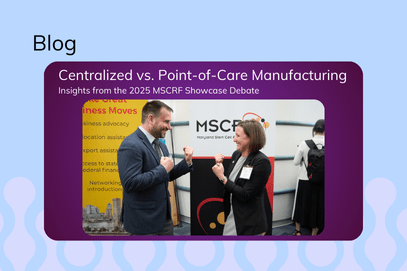A Checklist for a Successful Cell Therapy Tech Transfer
Catherine Tomaro-Duchesneau
PhD, Director, Manufacturing Science & Technology
While the technology transfer process is relatively straightforward for monoclonal antibodies and recombinant proteins, the transfer of cell therapies can be more challenging. Here’s a checklist to help ensure a successful transfer.
1. Set the Stage for a Successful Handoff
Multiple functional groups must be involved in the transfer and should include Manufacturing Science and Technology (MS&T), Analytical, Quality, Manufacturing and Supply Chain teams from both the client (sending unit) and the CDMO. A critical early step is a cross-functional gap assessment led by the MS&T group and involves a multidisciplinary team. This assessment focuses on the process and associated documentation, as well as the supply chain to ensure availability of raw materials and establish secondary options.
At this time, non-GMP materials are transferred over to GMP grade, and the current state of assays is evaluated to determine whether any additional work is needed prior to qualification and validation.
2. Have a Realistic Timeline with Contingency Plans
The timeline for a tech transfer can vary depending on the state of the incoming process and whether the transfer is into process development or manufacturing. If the proper amount of time is not invested in the tech transfer process, process or analytical gaps might not be fully addressed, requiring perhaps double or triple the time and money to fix later. A skilled and experienced team at the CDMO will have alternative plans ready in case something does not work as expected.
3. Set Up Early for GMP
It is important to use GMP grade materials relatively early in the process or at the very least assess the differences between the grades to minimize any impact. In the case of antibodies which are critical to both processes and analytics, a GMP versus non-GMP grade most likely originates from a different clone; because of this, the antibodies can’t be expected to behave in the same way.
7 Step Checklist for Cell Therapy Tech Transfer
The same is true for viral vectors where there are different characterization profiles for research versus GMP grade. During the tech transfer process, the materials being tested should be the ones that will be used in clinical manufacturing.
4. Ensure Robust Communication and Transparency
The relationship between the client and the CDMO should be built upon a shared commitment to collaborative problem solving, trust, and transparency. It is imperative that the client is upfront about any pain points and challenges they have experienced in their process and their current timeline constraints.
At the same time, the CDMO must proactively communicate with the client and be open about project and timeline risks throughout the entirety of the tech transfer. Establish the mode, timing, and frequency of communication.
5. Define Success Criteria
If success criteria such as target yield and stability of incoming material are not proactively established, it is impossible to know if a process has been successfully transferred. The process might result in the proper phenotype and the necessary analytics may be in place, but if there aren’t enough cells, the clinical site can’t be supplied. Stability data should be defined early in the process to guide the decision to either manufacture at risk or not manufacture at all in case a shipment is delayed.
In addition, it is important to collect information from lots that have failed; data from the failed runs should not be dismissed as they can provide important insight into the process and the critical process parameters.
6. Ensure Analytical Methods are Robust
A critical part of the gap analysis focuses on the analytics that will be required to support the process. Critical questions should be considered during analytical development, including whether the cell phenotype is the most important aspect and how functionality and potency come into play.
At the end of the day, it is essential to understand which markers are important for release and that the release criteria are appropriate for the product.
7. Select the Right Partner
Select the right CDMO and the process is seamless, efficient, and delivers against corporate and clinical milestones. Choose the wrong partner and missteps and delays are inevitable.
Your CDMO should act as a steward of your process and product. They should be capable of scrutinizing a process to identify where there might be problems in taking the science into manufacturing. They will pressure test the process and put it through its paces to see if it can hold up in a manufacturing setting.
Keep this tech transfer checklist in mind and you can minimize risk and ensure a smooth and efficient technology transfer.
Read more on what it takes to have a successful tech transfer:
7 Step Checklist for Cell Therapy Tech Transfer


